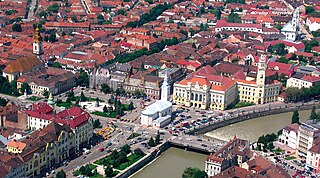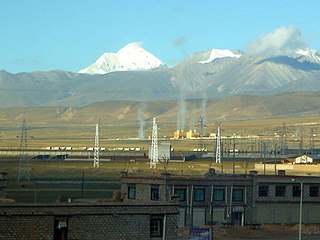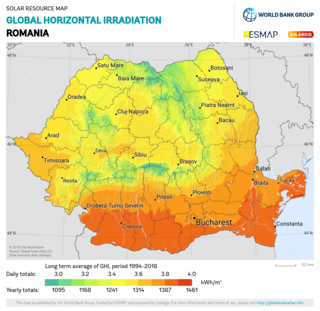Related Research Articles

Geothermal energy is the thermal energy in the Earth's crust which originates from the formation of the planet and from radioactive decay of materials in currently uncertain but possibly roughly equal proportions. The high temperature and pressure in Earth's interior cause some rock to melt and solid mantle to behave plastically. This results in parts of the mantle convecting upward since it is lighter than the surrounding rock. Temperatures at the core–mantle boundary can reach over 4000 °C (7200 °F).

Oradea is a city in Romania, located in Crișana, a sub-region of Transylvania. Seat of the Bihor county, Oradea is one of the most important economic, social and cultural centers in the western part of Romania. The city is located in the north-west of the country, nestled between hills on the Crișana plain, on the banks of the river Crișul Repede, that divides the city into almost equal halves.

Satu Mare is a city with a population of 102,400 (2011). It is the capital of Satu Mare County, Romania, as well as the centre of the Satu Mare metropolitan area. It lies in the region of Maramureș, broadly part of Transylvania. Mentioned in the Gesta Hungarorum as castrum Zotmar, the city has a history going back to the Middle Ages. Today, it is an academic, cultural, industrial, and business centre in the Nord-Vest development region.

Geothermal heating is the direct use of geothermal energy for some heating applications. Humans have taken advantage of geothermal heat this way since the Paleolithic era. Approximately seventy countries made direct use of a total of 270 PJ of geothermal heating in 2004. As of 2007, 28 GW of geothermal heating capacity is installed around the world, satisfying 0.07% of global primary energy consumption. Thermal efficiency is high since no energy conversion is needed, but capacity factors tend to be low since the heat is mostly needed in the winter.

District heating is a system for distributing heat generated in a centralized location through a system of insulated pipes for residential and commercial heating requirements such as space heating and water heating. The heat is often obtained from a cogeneration plant burning fossil fuels or biomass, but heat-only boiler stations, geothermal heating, heat pumps and central solar heating are also used, as well as heat waste from factories and nuclear power electricity generation. District heating plants can provide higher efficiencies and better pollution control than localized boilers. According to some research, district heating with combined heat and power (CHPDH) is the cheapest method of cutting carbon emissions, and has one of the lowest carbon footprints of all fossil generation plants.

Oradea Airport is an international airport located 5 km (3.1 mi) southwest of Oradea in northwestern Romania, Bihor County, near one of the main road and rail border crossings to Hungary. Its location near the European route E60 and the future Transylvania motorway as well as the county's high tourist potential have led to a double digit growth of passenger and cargo traffic for the past two years.

A ground source heat pump is a heating/cooling system for buildings that uses a type of heat pump to transfer heat to or from the ground, taking advantage of the relative constancy of temperatures of the earth through the seasons. Ground source heat pumps (GSHPs) – or geothermal heat pumps (GHP) as they are commonly termed in North America – are among the most energy-efficient technologies for providing HVAC and water heating, using far less energy than can be achieved by burning a fuel in a boiler/furnace or by use of resistive electric heaters.

The Narva Power Plants are a power generation complex in and near Narva in Estonia, near the border with Leningrad Oblast, Russia. The complex consists of the world's two largest oil shale-fired thermal power plants, Eesti Power Plant and Balti Power Plant. In 2007, Narva Power Plants generated about 95% of total power production in Estonia. The complex is owned and operated by AS Narva Elektrijaamad, a subsidiary of Eesti Energia.

The potential for exploiting geothermal energy in the United Kingdom on a commercial basis was initially examined by the Department of Energy in the wake of the 1973 oil crisis. Several regions of the country were identified, but interest in developing them was lost as petroleum prices fell. Although the UK is not actively volcanic, a large heat resource is potentially available via shallow geothermal ground source heat pumps, shallow aquifers and deep saline aquifers in the mesozoic basins of the UK. Geothermal energy is plentiful beneath the UK, although it is not readily accessible currently except in specific locations.

Iceland is a world leader in renewable energy. 100% of Iceland's electricity grid is produced from renewable resources. In terms of total energy supply, 85% of the total primary energy supply in Iceland is derived from domestically produced renewable energy sources. Geothermal energy provided about 65% of primary energy in 2016, the share of hydropower was 20%, and the share of fossil fuels was 15%.

Geothermal energy in Turkey is a significant part of renewable energy in Turkey. It generates 3% of electricity and is also used for geothermal heating. There is almost 2 gigawatts of electrical geothermal power. Geothermal power in Turkey began in the late 20th century, and over 60 power plants operate in Turkey as of 2020, with potential for more. As well as the electricity sector in Turkey, geothermal heat is used directly. At the end of 2021 Turkey had 1.7 GW installed electricity capacity, the fourth largest in the world: and for heat is second only to China. All power plants are in Western Anatolia, as it is especially resource rich.

Asociația Club Sportiv CAO 1910 Oradea, commonly known as Club Atletic Oradea, CA Oradea, or simply as CAO, is an amateur Romanian football club based in Oradea, Bihor County.

Geothermal exploration began in China in the 1970s. It was initially handled by national bodies with public investments, and productive wells were transferred free of charge to the final user. Since the mid-1990s, under the framework of privatization and liberalization of the economy, national investment in exploration has been reduced. No new plants have been commissioned in the period 2000–2005. The only electricity-producing fields are located in Tibet. According to the "2005 Chinese Geothermal Environment Bulletin" by China's Ministry of Land and Resources, the direct utilization of geothermal energy in China will reach 13.76 cubic meters per second, and the geothermal energy will reach 10,779 megawatts, ranking first in the world.

Solar power in Romania had an installed capacity of 1,374 megawatt (MW) as of the end of 2017. The country had in 2007 an installed capacity of 0.30 MW, which increased to 3.5 MW by the end of 2011, and to 6.5 MW by the end of 2012. However, the record year of 2013 was an exception, and new installation fell back from 1,100 MW to a moderate level of 69 MW in 2014.
Geothermal energy is the second most used form of renewable energy in Russia but represents less than 1% of the total energy production. The first geothermal power plant in Russia, which was the first Binary cycle power station in the world, was built at Pauzhetka, Kamchatka, in 1966, with a capacity of 5 MW. The total geothermal installed capacity is 81.9 MW, with 50 MW coming from a plant at Verkhne-Mutnovsky.Two other plants were built on the Kamchatka Peninsula in 1999 and 2002. Two smaller additional plants were installed on the islands of Kunashir and Iturup in 2007. Most geothermal resources are currently used for heating settlements in the North Caucasus and Kamchatka. Half of the geothermal production is used to heat homes and industrial buildings, one third is used to heat greenhouses and 13% is used for industrial processes.

Renewable energy has developed rapidly in Italy over the past decade and provided the country a means of diversifying from its historical dependency on imported fuels. Solar power accounted for around 8% of the total electric production in the country in 2014, making Italy the country with the highest contribution from solar energy in the world that year. Rapid growth in the deployment of solar, wind and bio energy in recent years lead to Italy producing over 40% of its electricity from renewable sources in 2014.
The Kızıldere Geothermal Power Plant is a geothermal power plant located at Kızıldere village of Sarayköy district in Denizli Province, southwestern Turkey. The initial power plant with 15 MW installed capacity was expanded in the second phase about 80 MW to 95 MW in total, making the facility Turkey's biggest geothermal power plant. It is planned to expand the power plant in a third and fourth phase.

Although there are plenty of renewable resources for energy in Turkey, only hydropower has been much developed, averaging about a fifth of national electricity supply. However, because this is vulnerable to droughts, less electricity than usual is from hydro in those recent years, compared to around a third in a wet year. Over half of capacity is renewables and it is estimated that over half of generation could be from renewables by 2026 but Turkey has invested less in solar and wind power than similar Mediterranean countries. Turkey needs a renewable energy plan beyond 2023 which includes transport, industry, heating and cooling as well as electricity generation. Turkey is a net exporter of wind power equipment but a net importer of solar power equipment.
Renewable energy in Chile is classified as Conventional and Non Conventional Renewable Energy (NCRE), and includes biomass, hydro-power, geothermal, wind and solar among other energy sources. Most of the time, when referring to Renewable Energy in Chile, it will be the Non Conventional kind.

Hungary is a member of the European Union and thus takes part in the EU strategy to increase its share of renewable energy. The EU has adopted the 2009 Renewable Energy Directive, which included a 20% renewable energy target by 2020 for the EU. By 2030 wind should produce in average 26-35% of the EU's electricity and save Europe €56 billion a year in avoided fuel costs. The national authors of Hungary forecast is 14.7% renewables in gross energy consumption by 2020, exceeding their 13% binding target by 1.7 percentage points. Hungary is the EU country with the smallest forecast penetration of renewables of the electricity demand in 2020, namely only 11%.
References
- ↑ "ENERGIA GEOTERMALA" (in Romanian). Asociatia Generala a Inginerilor din Romania. 2009-03-16. Archived from the original on 2009-02-16. Retrieved 2009-03-16.
- ↑ "Energia geotermala, o alternativa pentru Oradea - Stiri Oradea" (in Romanian). oron.ro. 2008-01-21. Retrieved 2009-03-16.
- ↑ "Oradea - energie geotermala" (in Romanian). ondrill.ro. 2009-02-19. Retrieved 2009-03-16.
